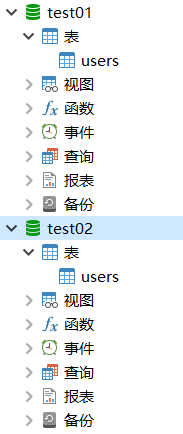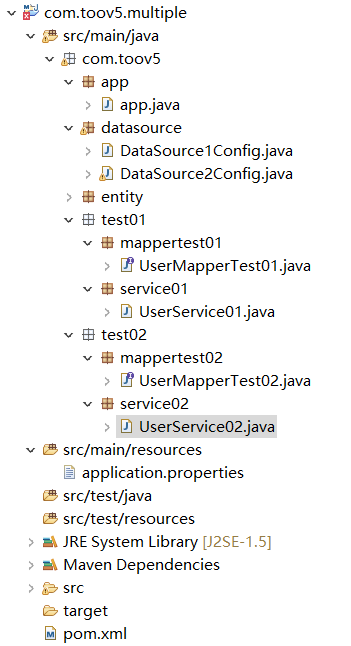Spring Boot2.0之整合多数据源
一般公司分两个数据库:
一个放共同配置文件, 一个数据库垂直业务数据库
垂直拆分和水平拆分:
垂直是根据业务划分具体数据库
在一个项目中有多个数据源(不同库jdbc) 无限个的哈~ 根据包名 或者 注解方式 划分多个数据源
本博客讲解的是分包情况下的:
首先创建两个包

数据库也是如此:

当前的目录结构这样:

根据不同的包名字,连接不同的数据源
pom文件如下所示:
<project xmlns="http://maven.apache.org/POM/4.0.0" xmlns:xsi="http://www.w3.org/2001/XMLSchema-instance" xsi:schemaLocation="http://maven.apache.org/POM/4.0.0 http://maven.apache.org/xsd/maven-4.0.0.xsd">
<modelVersion>4.0.0</modelVersion>
<groupId>multipleDatasource</groupId>
<artifactId>com.toov5.multiple</artifactId>
<version>0.0.1-SNAPSHOT</version> <parent>
<groupId>org.springframework.boot</groupId>
<artifactId>spring-boot-starter-parent</artifactId>
<version>2.0.0.RELEASE</version>
</parent>
<dependencies>
<dependency>
<groupId>org.springframework.boot</groupId>
<artifactId>spring-boot-starter</artifactId>
</dependency>
<!-- 测试 -->
<dependency>
<groupId>org.springframework.boot</groupId>
<artifactId>spring-boot-starter-test</artifactId>
<scope>test</scope>
</dependency>
<dependency>
<groupId>org.mybatis.spring.boot</groupId>
<artifactId>mybatis-spring-boot-starter</artifactId>
<version>1.1.1</version>
</dependency>
<!-- mysql 依赖 -->
<dependency>
<groupId>mysql</groupId>
<artifactId>mysql-connector-java</artifactId>
</dependency>
<!-- springboot-web组件 -->
<dependency>
<groupId>org.springframework.boot</groupId>
<artifactId>spring-boot-starter-web</artifactId>
</dependency>
<dependency>
<groupId>org.projectlombok</groupId>
<artifactId>lombok</artifactId>
</dependency> </dependencies> </project>
数据源的配置文件:application.properties
###datasource1
spring.datasource.test1.driver-class-name = com.mysql.jdbc.Driver
spring.datasource.test1.jdbc-url = jdbc:mysql://localhost:3306/test01?useUnicode=true&characterEncoding=utf-8
spring.datasource.test1.username = root
spring.datasource.test1.password = root
###datasource2
spring.datasource.test2.driver-class-name = com.mysql.jdbc.Driver
spring.datasource.test2.jdbc-url = jdbc:mysql://localhost:3306/test02?useUnicode=true&characterEncoding=utf-8
spring.datasource.test2.username = root
spring.datasource.test2.password = root
datasource包下面的相关配置的Java代码:
package com.toov5.datasource; import javax.sql.DataSource; import org.apache.ibatis.session.SqlSessionFactory;
import org.mybatis.spring.SqlSessionFactoryBean;
import org.mybatis.spring.SqlSessionTemplate;
import org.mybatis.spring.annotation.MapperScan;
import org.springframework.beans.factory.annotation.Qualifier;
import org.springframework.boot.context.properties.ConfigurationProperties;
import org.springframework.boot.jdbc.DataSourceBuilder;
import org.springframework.context.annotation.Bean;
import org.springframework.context.annotation.Configuration;
import org.springframework.context.annotation.Primary;
import org.springframework.jdbc.datasource.DataSourceTransactionManager; //DataSource01数据源的读取
@Configuration // 注册到springboot容器中
@MapperScan(basePackages = "com.toov5.test01", sqlSessionFactoryRef = "test1SqlSessionFactory")
//指向了下面的名为 test1SqlSessionFactory 的工厂
public class DataSource1Config { @Bean(name = "test1DataSource") //表示注入到Spring 容器中去
@ConfigurationProperties(prefix = "spring.datasource.test1") //表以此为开头,去properties去读 ( 后面是写死的)
@Primary
public DataSource testDataSource() {
return DataSourceBuilder.create().build();
} @Bean(name = "test1SqlSessionFactory") //
@Primary
public SqlSessionFactory testSqlSessionFactory(@Qualifier("test1DataSource") DataSource dataSource)
throws Exception {
SqlSessionFactoryBean bean = new SqlSessionFactoryBean();
bean.setDataSource(dataSource);
// bean.setMapperLocations(
// new
// PathMatchingResourcePatternResolver().getResources("classpath:mybatis/mapper/test1/*.xml"));
// 如果有一些mapper文件的话 可以把上面的注解放开
return bean.getObject();
} @Bean(name = "test1TransactionManager") //配置事务
@Primary
public DataSourceTransactionManager testTransactionManager(@Qualifier("test1DataSource") DataSource dataSource) {
return new DataSourceTransactionManager(dataSource);
} @Bean(name = "test1SqlSessionTemplate")
@Primary
public SqlSessionTemplate testSqlSessionTemplate(
@Qualifier("test1SqlSessionFactory") SqlSessionFactory sqlSessionFactory) throws Exception {
return new SqlSessionTemplate(sqlSessionFactory);
} }
和
package com.toov5.datasource; import javax.sql.DataSource; import org.apache.ibatis.session.SqlSessionFactory;
import org.mybatis.spring.SqlSessionFactoryBean;
import org.mybatis.spring.SqlSessionTemplate;
import org.mybatis.spring.annotation.MapperScan;
import org.springframework.beans.factory.annotation.Qualifier;
import org.springframework.boot.context.properties.ConfigurationProperties;
import org.springframework.boot.jdbc.DataSourceBuilder;
import org.springframework.context.annotation.Bean;
import org.springframework.context.annotation.Configuration;
import org.springframework.context.annotation.Primary;
import org.springframework.jdbc.datasource.DataSourceTransactionManager; //DataSource2
@Configuration // 注册到springboot容器中
@MapperScan(basePackages = "com.toov5.test02", sqlSessionFactoryRef = "test2SqlSessionFactory")
public class DataSource2Config { @Bean(name = "test2DataSource")
@ConfigurationProperties(prefix = "spring.datasource.test2")
public DataSource testDataSource() {
return DataSourceBuilder.create().build();
} @Bean(name = "test2SqlSessionFactory")
public SqlSessionFactory testSqlSessionFactory(@Qualifier("test2DataSource") DataSource dataSource)
throws Exception {
SqlSessionFactoryBean bean = new SqlSessionFactoryBean();
bean.setDataSource(dataSource);
// bean.setMapperLocations(
// new
// PathMatchingResourcePatternResolver().getResources("classpath:mybatis/mapper/test2/*.xml"));
return bean.getObject();
} @Bean(name = "test2TransactionManager")
public DataSourceTransactionManager testTransactionManager(@Qualifier("test2DataSource") DataSource dataSource) {
return new DataSourceTransactionManager(dataSource);
} @Bean(name = "test2SqlSessionTemplate")
public SqlSessionTemplate testSqlSessionTemplate(
@Qualifier("test2SqlSessionFactory") SqlSessionFactory sqlSessionFactory) throws Exception {
return new SqlSessionTemplate(sqlSessionFactory);
} }
然后相应的实体类代码:
package com.toov5.entity; import lombok.Data; @Data
public class User {
private Integer age;
private String name;
private Integer id; }
mappertest01和mappertest02
package com.toov5.mappertest01; import org.apache.ibatis.annotations.Insert;
import org.apache.ibatis.annotations.Param; public interface UserMapperTest01 {
@Insert("insert into users values(null,#{name},#{age});")
public int insert(@Param("name") String name, @Param("age") Integer age); }
和
package com.toov5.mappertest02; import org.apache.ibatis.annotations.Insert;
import org.apache.ibatis.annotations.Param; public interface UserMapperTest02 {
@Insert("insert into users values(null,#{name},#{age});")
public int insert(@Param("name") String name, @Param("age") Integer age); }
service01和service02
package com.toov5.service01; import org.springframework.beans.factory.annotation.Autowired;
import org.springframework.stereotype.Service; import com.toov5.mappertest01.UserMapperTest01; import lombok.extern.slf4j.Slf4j; @Service
@Slf4j
public class UserService01 {
@Autowired
private UserMapperTest01 userMapperTest01; public int insertUser(String name, Integer age){
int result = userMapperTest01.insert(name, age);
log.info("####################",result);
return result;
}
}
和
package com.toov5.service02; import org.springframework.beans.factory.annotation.Autowired;
import org.springframework.stereotype.Service; import com.toov5.mappertest02.UserMapperTest02; import lombok.extern.slf4j.Slf4j; @Service
@Slf4j
public class UserService02 {
@Autowired
private UserMapperTest02 userMapperTest02; public int insertUser(String name, Integer age){
int result = userMapperTest02.insert(name, age);
log.info("####################",result);
return result;
}
}
controller类
package com.toov5.controller; import org.springframework.beans.factory.annotation.Autowired;
import org.springframework.web.bind.annotation.RequestMapping;
import org.springframework.web.bind.annotation.RestController; import com.toov5.test01.service01.UserService01; @RestController
public class MultiplyController {
@Autowired
private UserService01 userService01; @Autowired
private UserService01 userService02; @RequestMapping("/insertUser01")
public Integer insertUser1(String name, Integer age){
return userService01.insertUser(name, age);
} @RequestMapping("/insertUser02")
public Integer insertUser2(String name, Integer age){
return userService02.insertUser(name, age);
} }
启动类:
package com.toov5.app; import org.springframework.boot.SpringApplication;
import org.springframework.boot.autoconfigure.SpringBootApplication; @SpringBootApplication(scanBasePackages={"com.toov5.*"})
public class app { public static void main(String[] args) {
SpringApplication.run(app.class, args);
} }
启动后访问:

数据库:

访问:

数据库结果:

注:spring1.5时候 默认只想数据源 会报错~ 2.0之后得到了修复
Spring Boot2.0之整合多数据源的更多相关文章
- Spring Boot2.0之整合事物管理
首先Spring 事务分类 1.声明事务 原理:基于编程事务的 2.编程事务 指定范围 扫包去解决 3.事务原理:AOP技术 通过环绕通知进行了拦截 使用Spring 事务注意事项: 不要tr ...
- Spring Boot2.0之整合JSP
首先不建议整合JSP哈,spring boot 对jsp的支持力度不大. 内置tomcat不支持jsp. 注意:在创建项目时候一定是war类型的,而不是跟之前那个freemarker那种jar类型. ...
- Spring Boot2.0之 整合XXL-Job
参考git上面的 springboot demo 创建maven工程: pom: <project xmlns="http://maven.apache.org/POM/4.0.0&q ...
- Spring Boot2.0之整合Mybatis
我在写这个教程时候,踩了个坑,一下子折腾到了凌晨两点半. 坑: Spring Boot对于Mysql8.1的驱动支持不好啊 我本地安装的是Mysql8.1版本,在开发时候.pom提示不需要输入驱动版本 ...
- Spring Boot2.0之 整合Zookeeper集群
普通的连接: pom: <project xmlns="http://maven.apache.org/POM/4.0.0" xmlns:xsi="http://w ...
- Spring Boot2.0之 整合Redis集群
项目目录结构: pom: <project xmlns="http://maven.apache.org/POM/4.0.0" xmlns:xsi="http:// ...
- Spring Boot2.0之 整合Redis事务
Redis事物 Redis 事务可以一次执行多个命令, 并且带有以下两个重要的保证: 事务是一个单独的隔离操作:事务中的所有命令都会序列化.按顺序地执行.事务在执行的过程中,不会被其他客户端发送来的命 ...
- Spring Boot2.0之整合Redis
需要的maven依赖 jar包,是对Jedis的封装 maven依赖: <project xmlns="http://maven.apache.org/POM/4.0.0" ...
- Spring Boot2.0之整合log4j
传统方式打印日志比较复杂, 每次打印需要定义全局变量 private static final Logger logger = LoggerFactory.getLogger(SjpControlle ...
随机推荐
- 【重点突破】——Drag&Drop拖动与释放
一.引言 在学习HTML5新特性的时候,学到了Drag&Drop这两种拖放API,这里根据拖动的是“源对象”还是“目标对象”做两个小练习,主要是为了理解与应用HTML5为拖放行为提供的7个事件 ...
- 2017.2.28 activiti实战--第七章--Spring容器集成应用实例(五)普通表单
学习资料:<Activiti实战> 第七章 Spring容器集成应用实例(五)普通表单 第六章中介绍了动态表单.外置表单.这里讲解第三种表单:普通表单. 普通表单的特点: 把表单内容写在 ...
- js 考记忆力得小游戏
<!DOCTYPE html> <html lang="en"> <head> <meta charset="UTF-8&quo ...
- JSON 值转换
var Txt = '{"a":"1","b":"5","c":"5",&quo ...
- IE对CSS样式的数量和大小的限制
项目中遇到的问题,css写的样式无法渲染,各种百度后发现大概是这个原因: IE对CSS样式的数量和大小的限制 文档中只有前31个link或style标记关联的CSS能够应用. 从第32个开始,其标记关 ...
- 应用程序之UITableView的编辑模式
cell分层结构 效果展示 代码实现 一.cell的分层结构 二.效果展示 三.代码实现 // // ViewController.m // 01-TableView的删除实现 // // Creat ...
- Web前端开发--JS技术大梳理
什么是JS JavaScript是一种直译式脚本语言,是一种动态类型.弱类型.基于原型的语言,内置支持类型.它的解释器被称为JavaScript引擎,为浏览器的一部分,广泛用于客户端的脚本语 ...
- ubantu 下 修改mysql 默认编码
启动mysql后,以root登录mysql root@Eadgar-virtual-machine:~# mysql -uroot -proot mysql> show variables li ...
- null的比较问题
select count(*) from table_a WHERE status=1 and end_time<now(); 写这个sql的时候有点纠结,万一end_time是null怎么办 ...
- Spring cloud微服务实战——基于OAUTH2.0统一认证授权的微服务基础架构
https://blog.csdn.net/w1054993544/article/details/78932614
